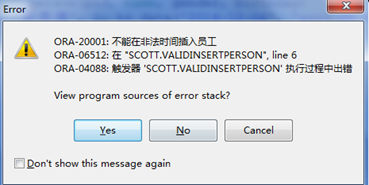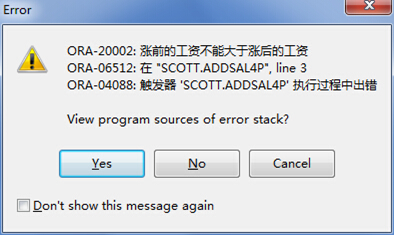4.pl/sql
什么是PL/SQL?
PL/SQL(Procedure Language/SQL)
PLSQL是Oracle对sql语言的过程化扩展,指在SQL命令语言中增加了过程处理语句(如分支、循环等),使SQL语言具有过程处理能力。把SQL语言的数据操纵能力与过程语言的数据处理能力结合起来,使得PLSQL面向过程但比过程语言简单、高效、灵活和实用。
范例1:为职工长工资,每人长10%的工资。
Update emp set sal=sal*1.1
范例2:例2: 按职工的职称长工资,总裁长1000元,经理长800元,其他人员长400元。
这样的需求我们就无法使用一条SQL来实现,需要借助其他程序来帮助完成,也可以使用pl/sql。
1. pl/sql程序语法
1.程序语法:
declare
说明部分 (变量说明,游标申明,例外说明 〕
begin
语句序列 (DML语句〕…
exception
例外处理语句
End;
2.常量和变量定义
在程序的声明阶段可以来定义常量和变量。
- 变量的基本类型就是oracle中的建表时字段的变量如char, varchar2, date, number, boolean, long),
定义语法:
varl char(15);
Psal number(9,2);
说明变量名、数据类型和长度后用分号结束说明语句。
常量定义:married boolean:=true
- 引用变量
Myname emp.ename%type;
引用型变量,即my_name的类型与emp表中ename列的类型一样
在sql中使用into来赋值
declare
emprec emp.ename%type;
begin
select t.ename into emprec from emp t where t.empno = 7369;
dbms_output.put_line(emprec);
end;
- 记录型变量
Emprec emp%rowtype
记录变量分量的引用
emp_rec.ename:='ADAMS';
declare
p emp%rowtype;
begin
select * into p from emp t where t.empno = 7369;
dbms_output.put_line(p.ename || ' ' || p.sal);
end;
3.if分支
语法1:
IF 条件 THEN 语句1;
语句2;
END IF;
语法2:
IF 条件 THEN 语句序列1;
ELSE 语句序列 2;
END IF;
语法3:
IF 条件 THEN 语句;
ELSIF 条件 THEN 语句;
ELSE 语句;
END IF;
范例1:如果从控制台输入1则输出我是1
declare
pnum number := #
begin
if pnum = 1 then
dbms_output.put_line('我是1');
end if;
end;
范例2:如果从控制台输入1则输出我是1否则输出我不是1
declare
mynum number := #
begin
if mynum = 1 then
dbms_output.put_line('我是1');
else
dbms_output.put_line('我不是1');
end if;
end;
范例3:判断人的不同年龄段18岁以下是未成年人,18岁以上40以下是成年人,40以上是老年人
declare
mynum number := #
begin
if mynum < 18 then
dbms_output.put_line('未成年人');
elsif mynum >= 18 and mynum < 40 then
dbms_output.put_line('中年人');
elsif mynum >= 40 then
dbms_output.put_line('老年人');
end if;
end;
4.LOOP循环语句
其中语法2比较常用
语法1:
WHILE total <= 25000 LOOP
……
total : = total + salary;
END LOOP;
语法2:
Loop
EXIT [when 条件];
……
End loop
语法3:
FOR I IN 1 …… 3 LOOP
语句序列 ;
END LOOP ;
范例:使用语法1输出1到10的数字
declare
step number := 1;
begin
while step <= 10 loop
dbms_output.put_line(step);
step := step + 1;
end loop;
end;
范例:使用语法2输出1到10的数字
declare
step number := 1;
begin
loop
exit when step > 10;
dbms_output.put_line(step);
step := step + 1;
end loop;
end;
范例:使用语法3输出1到10的数字
declare
step number := 1;
begin
for step in 1 .. 10 loop
dbms_output.put_line(step);
end loop;
end;
5.游标Cursor
在写java程序中有集合的概念,那么在pl/sql中也会用到多条记录,这时候我们就要用到游标,游标可以存储查询返回的多条数据。
语法:
CURSOR 游标名 [ (参数名 数据类型,参数名 数据类型,...)] IS SELECT 语句;
例如:cursor c1 is select ename from emp;
游标的使用步骤:
- 打开游标: open c1; (打开游标执行查询)
- 取一行游标的值:fetch c1 into pjob; (取一行到变量中)
- 关闭游标: close c1;(关闭游标释放资源)
- 游标的结束方式 exit when c1%notfound
- 注意: 上面的pjob必须与emp表中的job列类型一致:
定义:pjob emp.empjob%type;
范例1:使用游标方式输出emp表中的员工编号和姓名
declare
cursor pc is
select * from emp;
pemp emp%rowtype;
begin
open pc;
loop
fetch pc
into pemp;
exit when pc%notfound;
dbms_output.put_line(pemp.empno || ' ' || pemp.ename);
end loop;
close pc;
end;
范例2:按员工的工种长工资,总裁1000元,经理长800元其,他人员长400元。
declare
cursor pc is
select * from myemp;
addsal myemp.sal%type;
pemp myemp%rowtype;
begin
open pc;
loop
fetch pc
into pemp;
exit when pc%notfound;
if pemp.job = 'PRESIDENT' then
addsal := 1000;
elsif pemp.job = 'MANAGER' then
addsal := 800;
else
addsal := 400;
end if;
update myemp t set t.sal = t.sal + addsal where t.empno = pemp.empno;
end loop;
close pc;
end;
范例3:写一段PL/SQL程序,为部门号为10的员工涨工资。
declare
cursor pc(dno myemp.deptno%type) is
select empno from myemp where deptno = dno;
pno myemp.empno%type;
begin
open pc(20);
loop
fetch pc
into pno;
exit when pc%notfound;
update myemp t set t.sal = t.sal + 1000 where t.empno = pno;
end loop;
close pc;
end;
6.例外
例外是程序设计语言提供的一种功能,用来增强程序的健壮性和容错性。
系统定义例外
no_data_found (没有找到数据)
too_many_rows (select …into语句匹配多个行)
zero_divide ( 被零除)
value_error (算术或转换错误)
timeout_on_resource (在等待资源时发生超时)
范例1:写出被0除的例外的plsql程序
declare
pnum number;
begin
pnum := 1 / 0;
exception
when zero_divide then
dbms_output.put_line('被0除');
when value_error then
dbms_output.put_line('数值转换错误');
when others then
dbms_output.put_line('其他错误');
end;
用户也可以自定义例外,在声明中来定义例外
DECLARE
My_job char(10);
v_sal emp.sal%type;
No_data exception;
cursor c1 is select distinct job from emp order by job;
如果遇到异常我们要抛出raise no_data;
范例:查询部门编号是50的员工
declare
no_emp_found exception;
cursor pemp is
select t.ename from emp t where t.deptno = 50;
pename emp.ename%type;
begin
open pemp;
fetch pemp
into pename;
if pemp%notfound then
raise no_emp_found;
end if;
close pemp;
exception
when no_emp_found then
dbms_output.put_line('没有找到员工');
when others then
dbms_output.put_line('其他错误');
end;
2.存储过程
存储过程(Stored Procedure)是在大型数据库系统中,一组为了完成特定功能的SQL 语句集,经编译后存储在数据库中,用户通过指定存储过程的名字并给出参数(如果该存储过程带有参数)来执行它。存储过程是数据库中的一个重要对象,任何一个设计良好的数据库应用程序都应该用到存储过程。
创建存储过程语法:
create [or replace] PROCEDURE 过程名[(参数名 in/out 数据类型)]
AS
begin
PLSQL子程序体;
End;
或者
create [or replace] PROCEDURE 过程名[(参数名 in/out 数据类型)]
is
begin
PLSQL子程序体;
End 过程名;
范例:创建一个输出helloword的存储过程
create or replace procedure helloworld is
begin
dbms_output.put_line('helloworld');
end helloworld;
调用存储过程
在plsql中调用存储过程
begin
-- Call the procedure
helloworld;
end;
范例2:给指定的员工涨100工资,并打印出涨前和涨后的工资
分析:我们需要使用带有参数的存储过程
create or replace procedure addSal1(eno in number) is
pemp myemp%rowtype;
begin
select * into pemp from myemp where empno = eno;
update myemp set sal = sal + 100 where empno = eno;
dbms_output.put_line('涨工资前' || pemp.sal || '涨工资后' || (pemp.sal + 100));
end addSal1;
调用
begin
-- Call the procedure
addsal1(eno => 7902);
commit;
end;
3.存储函数
create or replace function 函数名(Name in type, Name in type, ...) return 数据类型 is
结果变量 数据类型;
begin
return(结果变量);
end函数名;
存储过程和存储函数的区别
- 一般来讲,过程和函数的区别在于函数可以有一个返回值;而过程没有返回值。但过程都可以通过out指定一个或多个输出参数。我们可以利用out参数,在过程和中实现返回多个值。
范例:使用存储函数来查询指定员工的年薪
create or replace function empincome(eno in emp.empno%type) return number is
psal emp.sal%type;
pcomm emp.comm%type;
begin
select t.sal into psal from emp t where t.empno = eno;
return psal * 12 + nvl(pcomm, 0);
end;
使用存储过程来替换上面的例子
create or replace procedure empincomep(eno in emp.empno%type, income out number) is
psal emp.sal%type;
pcomm emp.comm%type;
begin
select t.sal, t.comm into psal, pcomm from emp t where t.empno = eno;
income := psal*12+nvl(pcomm,0);
end empincomep;
调用:
declare
income number;
begin
empincomep(7369, income);
dbms_output.put_line(income);
end;
使用java代码调用存储过程和函数
/* Class.forName("oracle.jdbc.OracleDriver");
Connection conn = null;
conn = DriverManager.getConnection("jdbc:oracle:thin:@127.0.0.1:1521:orcl",
"scott", "tiger");
CallableStatement call = conn.prepareCall("{call countyearsal(?,?)}");
call.setInt(1, 7369);
call.registerOutParameter(2, OracleTypes.NUMBER);
call.execute();
int sum = call.getInt(2);
System.out.println(sum); */
Class.forName("oracle.jdbc.OracleDriver");
Connection conn = null;
conn = DriverManager.getConnection("jdbc:oracle:thin:@127.0.0.1:1521:orcl",
"scott", "tiger");
CallableStatement call = conn.prepareCall("{?= call countyearsal1(?)}");
call.registerOutParameter(1, OracleTypes.NUMBER);
call.setInt(2, 7369);
call.execute();
int sum = call.getInt(1);
System.out.println(sum);
4.触发器
数据库触发器是一个与表相关联的、存储的PL/SQL程序。每当一个特定的数据操作语句(Insert,update,delete)在指定的表上发出时,Oracle自动地执行触发器中定义的语句序列。
触发器可用于
- 数据确认
- 实施复杂的安全性检查
- 做审计,跟踪表上所做的数据操作等
- 数据的备份和同步
触发器的类型
- 语句级触发器 :在指定的操作语句操作之前或之后执行一次,不管这条语句影响了多少行 。
- 行级触发器(FOR EACH ROW) :触发语句作用的每一条记录都被触发。在行级触发器中使用old和new伪记录变量, 识别值的状态。
语法:
CREATE [or REPLACE] TRIGGER 触发器名
{BEFORE | AFTER}
{DELETE | INSERT | UPDATE [OF 列名]}
ON 表名
[FOR EACH ROW [WHEN(条件) ] ]
begin
PLSQL 块
End 触发器名
范例:插入员工后打印一句话“一个新员工插入成功”
create or replace trigger testTrigger
after insert on person
declare
-- local variables here
begin
dbms_output.put_line('一个员工被插入');
end testTrigger;
范例:不能在休息时间插入员工
create or replace trigger validInsertPerson
before insert on person
declare
weekend varchar2(10);
begin
select to_char(sysdate, 'day') into weekend from dual;
if weekend in ('星期一') then
raise_application_error(-20001, '不能在非法时间插入员工');
end if;
end validInsertPerson;
当执行插入时会报错

在触发器中触发语句与伪记录变量的值
| 触发语句 | :old | :new |
|---|---|---|
| Insert | 所有字段都是空(null) | 将要插入的数据 |
| Update | 更新以前该行的值 | 更新后的值 |
| delete | 删除以前该行的值 | 所有字段都是空(null) |
范例:判断员工涨工资之后的工资的值一定要大于涨工资之前的工资
create or replace trigger addsal4p
before update of sal on myemp
for each row
begin
if :old.sal >= :new.sal then
raise_application_error(-20002, '涨前的工资不能大于涨后的工资');
end if;
end;
调用
update myemp t set t.sal = t.sal - 1;

create tablespace my0108
logging
datafile 'D:\oracle\product\10.2.0\oradata\orcl\my0108.dbf'
size 32m
autoextend on
next 32m maxsize 2048m
extent management local;

